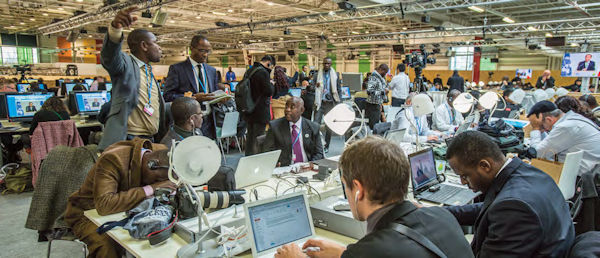SEJournal Online is the digital news magazine of the Society of Environmental Journalists. Learn more about SEJournal Online, including submission, subscription and advertising information.
Cover Story
By TIM McDONNELL
 |
| International press and delegation media staffs at the Climate Summit Media Centre show strain of chasing after 146 nations’ leaders and others during the first day of the meeting. More than 3000 journalists, including photographers and video crews, were registered for the summit. Photo: © Gary Braasch / WorldViewofGlobalWarming.org |
When they closed down the coffee shop, I was worried. But when they stopping selling wine, I was devastated.
It was Saturday night, and the global climate change summit in Paris was on the cusp of a climactic photo finish. There were no more formal negotiations, no more press conferences.
The cluster of airport hangars that had been converted into a conference center was beginning to shut down, including the café that had fed and watered the world’s climate journalists for the last two weeks. By the time I noticed, it was too late to stock up on celebratory booze.
Seated at desks in the cavernous press room, a few hundred other journalists and I gazed up at televisions piping in a live feed from the grand hall next door. French Foreign Minister Laurent Fabius was about to take the stage and announce the most ambitious diplomatic agreement on climate change in history.
He was a few hours late — at the last minute, lawyers from the U.S. team spotted a typo in the final text, an apparently inadvertent but potentially calamitous substitution of “shall” for “should” in a section describing developed countries’ obligations to reduce greenhouse gas emissions. But after 20 puttering years of climate talks, what were a few more hours?
The mood was electric. Finally, Fabius appeared, and with little ado declared that the Paris Agreement was hereby adopted. The press room erupted in cheers — particularly the members of one TV crew nearby who launched a cavalcade of loud, drunken toasts in an unidentifiable language. Clearly some people were better prepared to party than I was.
Amid the cacophony, someone reminded Fabius that protocol required he actually strike his green, leaf-shaped gavel.
“It is a very small hammer,” he said, giving it a nice whack. “But I think it will do great things.”
For environmental journalists, the overarching task of the foreseeable future is to track whether Fabius’ prediction pans out.
For journalists, agreement means reframing of climate story
Once their hangovers cleared, many activists, policy wonks, scientists and government officials quickly found things to dislike in the Paris Agreement.
It remains to be seen whether the document will truly propel meaningful global reductions of greenhouse gas emissions and the flow of funds to the most impacted communities for adapting to the changes that are already inevitable.
Still, it seems fair to say that Paris was a legitimate sea change in humankind’s campaign against climate change. The agreement, and the moment in time that produced it, represent a new foundation on which all future climate-oriented lawmaking, science, investment and activism will be built.
And for journalists, it represents a fundamental reframing of the story. More so than ever, perhaps even for the first time, climate change can be a story about real, meaningful progress — not the lack thereof.
In other words, that drunk TV crew really did have something to celebrate.
I don’t mean to suggest that the problem is solved. Any resident of a low-lying island nation or anyone who has followed the Republican presidential primary knows we ain’t out of the woods yet.
But optimism has been sparse in the two and a half decades since the preeminent climatologist James Hansen first warned Congress about global warming. Now, after Paris, there is an unprecedented level of opportunity to tell a story environmental journalists are rarely afforded: That the good guys are winning.
“One of the main changes post-Paris is that the question is no longer whether there will be action on climate, but the pace and scale of that change,” said Jennifer Morgan, director of the global climate program at the World Resources Institute.
Climate change is now legally recognized as a serious problem by nearly every country on Earth.
The global warming threshold enshrined in the agreement — “well below” 2 degrees Celsius above pre-industrial levels — provides a concrete point of reference with which to hold elected officials and industry leaders accountable.
Countless corporations, banks, universities, NGOs, militaries and other significant institutions have already elevated climate change as a priority that shouldn’t, can’t and won’t be ignored.
Energy solutions that seemed like pipe dreams only a few years ago, like widespread rooftop solar, are now multimillion-dollar businesses that rival the entrenched fossil fuel industries for employment and political clout.
President Barack Obama has stuffed climate policies into dozens of nooks and crannies across the executive branch, deep enough that they will be difficult or impossible for even the most anti-science future president to root out completely.
As for Congress…well, too much good news would just be boring, right?
Reporting on ‘forward momentum’
The upshot is that the tacit assumption lurking behind many climate stories of the last several years — that the problem is overwhelming and intractable — no longer rings true. Our audiences are sick of reading bummer climate stories, anyway.
These successes shouldn’t lead to complacency. Environmental journalists must be more vigilant than ever against corporate greenwashing, shoddy science, political denialism and other insidious threats to the public interest.
But now, we can afford to hold all of our stories to a higher standard of forward momentum on climate change.
Here are a few ideas for what to watch:
 |
| Exhibits at the climate summit, like this giant clownfish mural at the Indonesia pavilion, reminded the 38,000 registered attendees that human beings weren’t the only stakeholder species with an interest in the outcome of the climate negotiations. Photo: © Gary Braasch / WorldViewofGlobalWarming.org |
The big picture: In his final year in office, the president is likely to have a few final climate policies to unveil. But just as important will be the ongoing fight to protect the Clean Power Plan, his flagship regulation to limit greenhouse gas emissions from power plants. The plan is under legal attack from two dozen coal-reliant states, but is essential for the United States to live up to its Paris commitments. Will it survive? How is your state working — or not — to comply with the plan? What will the plan mean for issues like energy costs and employment in your area?
Paris also raised the stakes for climate change in the 2016 election season, since the next occupants of the White House and Congress will have to actually carry out Obama’s commitments — or not. And while, in the presidential race, climate is baldly partisan — Democratic candidates have vowed to continue Obama’s policies; Republicans have vowed to defeat them — there may be more interesting battles in your state’s Congressional and state legislature elections. That’s especially true for locales where climate impacts are already hitting hard, like drought-fatigued cropland in the Midwest or flood-battered coastal communities.
The local picture: In Paris, mayors were as potent a presence as ministers and heads of state. Cities are the loci of some of the most interesting developments in clean energy, improved public transit, highways and buildings made more resilient to adverse weather, and other vital climate initiatives. How are elected officials in your coverage area pushing plans to mitigate and adapt to climate change? If they aren’t, why aren’t they?
Other local institutions, like small businesses and universities, should face the same questions. For example, in “Dark Money,” Jane Mayer’s excellent new account of the Koch brothers’ political empire, I was surprised to learn that the University of Arizona, my alma mater, is one of the largest recipients of Koch funding. Because the Kochs’ fortune is derived largely from fossil fuels and has been employed to impede action on climate change, that relationship and others like it deserve more scrutiny.
Clean energy: Paris confirmed that there’s a bright future ahead for clean energy technologies. Massive increases in renewable energy use were the most common strategy promised by countries around the world to reduce their carbon footprints. What will that mean for your area? Who are the new winners and losers in the rapidly changing energy sector? How are officials in your area helping or hindering that transition?
In Nevada, for example, regulators recently changed electricity metering rules in a way that severely undercut rooftop solar’s cost advantage; as a result, several major solar companies jumped ship, taking hundreds of jobs with them. Battles like this are playing out across the country.
Follow the money: No one expects the transition to a cleaner economy to be cheap. U.N. officials have called for global investment in energy efficiency and clean energy to reach $1 trillion per year from now to 2050, but today we’re at only one-third of that target. Watch closely as the country’s biggest investors — think banks big and small, pension funds, state treasurers and the like — shift more of the money they manage (some of which may belong to you) into green projects. How will the U.N. manage the so-called Green Climate Fund, which aims to pour cash into green development projects?
Meanwhile, momentum is gathering at universities and elsewhere to divest invested holdings from fossil fuels. Will that movement continue to grow? What impact will it truly have?
Look abroad: China and India both made commitments in Paris that could have significant ramifications for the global economy. Will China be able to curb its coal addiction? How will Chinese solar and wind manufacturers compete in the global market with their American and European rivals? Will India succeed in delivering energy access to millions of its poorest citizens without dramatically increasing its carbon footprint?
At the same time, climate change impacts like drought could prove a major threat to peace and stability in vulnerable regions of the world, especially the Middle East and sub-Saharan Africa. And geopolitical tensions between Russia, the United States and other Arctic superpowers are heating up as polar ice melts and the race quickens to secure natural resources and shipping routes. How will the U.S. military respond? How will climate change impact diplomacy, trade, human rights, global health and other vital international issues?
Of course, all these ideas were on the table before Paris, and may not relate directly to the agreement per se. But if nothing else, Paris was the final notice to politicians, CEOs and other public figures that denial of climate science and opposition to — or even passivity about — solutions is no longer a defensible position. I’ll drink to that.
Tim McDonnell is associate producer at Climate Desk, and served in previous stints at Mother Jones and Sierra magazines. He is originally from Tucson.
Photographer Gary Braasch is an environmental photojournalist based in Portland, Ore., who has extensively covered climate change at his website, www.worldviewofglobalwarming.org, for more than ten years. He previously reported for SEJournal in both pictures and words on the Copenhagen climate conference in the Spring 2010 issue (page 16).
* From the quarterly news magazine SEJournal, Spring 2016. Each new issue of SEJournal is available to members and subscribers only; find subscription information here or learn how to join SEJ. Past issues are archived for the public here.













 Advertisement
Advertisement 



